India, the world’s most populous country, is also among the most vulnerable to climate hazards. That’s not only because of the heat and floods that global warming has exacerbated, but also because so many of the country’s 1.4 billion people are vulnerable to begin with. Most people are poor, by global standards, and they have no safety net.
Early election results Tuesday signaled that the party led by Narendra Modi, the two-term Hindu nationalist Indian prime minister, is poised to win the largest number of seats in the Indian parliament but may have to join with smaller parties to form a coalition government.
That government will face major challenges brought on by climate change.
Heat is now an election issue, literally.
The six-week process of voting took place amid a scorching heat wave in several parts of the country. In the northern states of Bihar and Uttar Pradesh, at least 33 people, including poll workers, died of complications from the heat last week, according to government authorities cited by Reuters.
Rohit Magotra, deputy director of Integrated Research and Action for Development, called on national election officials to reschedule elections in the future to avoid such calamities. He pointed out that workers from every political party suffer in the heat, and so do voters, who often have to line up under the sun.
“I definitely see the momentum building up, and elections are unlikely to be scheduled in peak summer in future,” said Mr. Magotra, whose organization has advocated heat solutions in Indian cities.
The Election Commission this year did set up a task force to monitor weather conditions, but only after voting got underway amid abnormally high temperatures. It also sent election workers a list of heat precautions prepared by the National Disaster Management Agency. However, according to a report published in Scroll, an Indian news site, political-party campaigners were not told to do anything differently because of the heat.
While parliamentary elections are traditionally scheduled in summer in India, climate change is making summers increasingly dangerous. This year, one weather station in Delhi broke the all-time temperature record with a reading above 52 degrees Celsius (127 degrees Fahrenheit) in late May. It was the third consecutive year of abnormally high temperatures in India, all made worse by climate change, according to scientific studies of the heat waves.
Several cities and states have heat action plans, at least on paper. But as one independent analysis concluded last year, they are mostly underfunded and lack concrete ways to identify and protect the most vulnerable.
Farmers, politically powerful, are angry.
Mr. Modi’s government has faced some of the most potent opposition in recent years from farmers’ organizations. And many of their concerns are rooted in climate issues.
Their agitation reflects a deep malaise in agriculture, a major slice of the Indian economy. More than half of all Indians depend on farming to make a living. Groundwater is in short supply in many important agricultural regions. Farmers are in deep debt in many parts of the country.
On top of that, extreme weather and unpredictable rains have wrecked harvests repeatedly in recent years.
In 2020, hundreds of thousands of farmers, mostly from India’s breadbasket region of Punjab and Haryana, erected encampments outside of New Delhi and rolled their tractors into the capital in protests that turned violent. Their initial grievance was over Mr. Modi’s efforts to open up more private investment in agriculture, which the farmers said would make them vulnerable to low prices driven by corporate profit motives.
In the face of the uprising, the government backed down, a rarity for Mr. Modi, but also one that signals the seriousness with which his administration took the protests.
Again this year, farmers marched on the capital, this time demanding higher government-set prices for wheat and rice.
The global image of India is often associated with its fast-growing economy, its vibrant cities and its massive, young work force. But a majority of its people still depend on farm incomes, most of its 770 million poor people live in the countryside, and the government has been unable to create anywhere near the number of jobs outside agriculture that its booming youth population demands. Fixing agriculture in the era of climate change is likely to be among Mr. Modi’s most profound challenges in the coming years.
“Definitely, increasing extreme weather events (floods, heat waves, storms) are the most important climate challenge facing the government,” said M. Rajeevan, a former secretary in the Earth Sciences Ministry who is now vice chancellor at Atria University in Bengaluru.
Then there’s India’s coal habit.
Climate change is driven principally by the burning of fossil fuels, the dirtiest of which is coal.
At international summits, Mr. Modi has emphasized his push to build renewable energy infrastructure. At the same time though, his government has continued to expand coal.
That’s driven by both political and economic considerations. Coal is the incumbent fuel. Public and private companies, many of them politically connected, are invested in coal. The government’s main interest is in keeping electricity prices low.
Coal remains the country’s biggest source of electricity. Coal use grew this year, partly driven by climate change itself.
Higher temperatures drive up demand for air-conditioners and fans, which drives up demand for electricity. India’s power-sector emissions soared in the first quarter of 2024, according to Ember, a research organization that tracks emissions.
Coal provides more than 70 percent of India’s electricity, with solar and wind accounting for a little more than 10 percent. And even though the government has set an ambitious target of 500 gigawatts of renewable energy capacity by 2030, coal’s influence is unlikely to dim anytime soon. According to government projections, coal will still supply more than half of India’s electricity in 2030.






